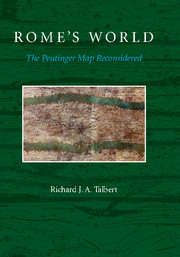Book contents
- Frontmatter
- Contents
- List of Plates, Figures, and Table
- Preface and Acknowledgments
- Abbreviations
- INTRODUCTION
- 1 THE SURVIVING COPY: HISTORY, PUBLICATION, SCHOLARSHIP
- 2 THE SURVIVING COPY: THE MATERIAL OBJECT AND ITS PALEOGRAPHY
- 3 THE DESIGN AND CHARACTER OF THE MAP
- 4 RECOVERY OF THE ORIGINAL MAP FROM THE SURVIVING COPY
- 5 THE ORIGINAL MAP
- CONCLUSION: THE MAP'S PLACE IN CLASSICAL AND MEDIEVAL CARTOGRAPHY
- APPENDIX 1 Latin Text Appended to the 1598 Engraving of the Map
- APPENDIX 2 English Translation of J. Kastelic, “Vodnikova kopija Tabule Peutingeriane” (trans. Gerald Stone)
- APPENDIX 3 Reflections on Vodnik's Copy of von Scheyb's Engraving
- APPENDIX 4 Vodnik's Latin Summary of Heyrenbach's Essay (National Library of Slovenia, Ljubljana, MS 1443)
- APPENDIX 5 Miller's Reconstruction of the Map's Western End
- APPENDIX 6 Wyttenbach's Claim: A Lost Piece of the Map Discovered
- APPENDIX 7 User's Guide to the Database and Commentary
- APPENDIX 8 User's Guide to the Map (A) and Overlaid Layers
- APPENDIX 9 User's Guide to the Outlining of Rivers and Routes on Barrington Atlas Bases (C–F), with Associated Texts: (a) Antonine Itinerary (ItAnt) Text with Journeys Numbered as on Map E, and (b) Bordeaux Itinerary (ItBurd) Text with Journeys Lettered as on Map F
- Notes
- Bibliography
- Index and Gazetteer
APPENDIX 9 - User's Guide to the Outlining of Rivers and Routes on Barrington Atlas Bases (C–F), with Associated Texts: (a) Antonine Itinerary (ItAnt) Text with Journeys Numbered as on Map E, and (b) Bordeaux Itinerary (ItBurd) Text with Journeys Lettered as on Map F
- Frontmatter
- Contents
- List of Plates, Figures, and Table
- Preface and Acknowledgments
- Abbreviations
- INTRODUCTION
- 1 THE SURVIVING COPY: HISTORY, PUBLICATION, SCHOLARSHIP
- 2 THE SURVIVING COPY: THE MATERIAL OBJECT AND ITS PALEOGRAPHY
- 3 THE DESIGN AND CHARACTER OF THE MAP
- 4 RECOVERY OF THE ORIGINAL MAP FROM THE SURVIVING COPY
- 5 THE ORIGINAL MAP
- CONCLUSION: THE MAP'S PLACE IN CLASSICAL AND MEDIEVAL CARTOGRAPHY
- APPENDIX 1 Latin Text Appended to the 1598 Engraving of the Map
- APPENDIX 2 English Translation of J. Kastelic, “Vodnikova kopija Tabule Peutingeriane” (trans. Gerald Stone)
- APPENDIX 3 Reflections on Vodnik's Copy of von Scheyb's Engraving
- APPENDIX 4 Vodnik's Latin Summary of Heyrenbach's Essay (National Library of Slovenia, Ljubljana, MS 1443)
- APPENDIX 5 Miller's Reconstruction of the Map's Western End
- APPENDIX 6 Wyttenbach's Claim: A Lost Piece of the Map Discovered
- APPENDIX 7 User's Guide to the Database and Commentary
- APPENDIX 8 User's Guide to the Map (A) and Overlaid Layers
- APPENDIX 9 User's Guide to the Outlining of Rivers and Routes on Barrington Atlas Bases (C–F), with Associated Texts: (a) Antonine Itinerary (ItAnt) Text with Journeys Numbered as on Map E, and (b) Bordeaux Itinerary (ItBurd) Text with Journeys Lettered as on Map F
- Notes
- Bibliography
- Index and Gazetteer
Summary
Map C outlines the Peutinger map's rivers eastward as far as the Euphrates and Tigris on BAtlas bases;
Map D outlines the Peutinger map's routes on BAtlas bases – but not beyond Maps 87 and 89, because too little is known for certain hereon;
Map E outlines the Antonine Itinerary's routes (ItAnt) on BAtlas bases;
Map F outlines the Bordeaux Itinerary's routes (ItBurd) on BAtlas bases.
Maps C–F may be overlaid upon one another. Each has the same “mosaic” of bases, which allows the user to proceed seamlessly through BAtlas. A Locator Outline (Fig. 7) of the BAtlas maps comprising the mosaic forms part of this Appendix. Each individual BAtlas map can be brought into the mosaic, or removed, as the user wishes. Be aware that, where two or more overlap, the upper map may need to be removed in order for certain data marked on the lower to be seen.
The mosaic presents these BAtlas maps at a consistent scale, which the user may enlarge or reduce freely. Caution: These maps were all produced for presentation at either 1:1,000,000 or 1:500,000 scale (shown on the Locator Outline); as with any map, the results are liable to prove unsatisfactory if an enlargement is attempted far in excess of the original scale. The lack of high definition in the maps' presentation reflects their intended role as no more than background here.
- Type
- Chapter
- Information
- Rome's WorldThe Peutinger Map Reconsidered, pp. 203 - 286Publisher: Cambridge University PressPrint publication year: 2010



